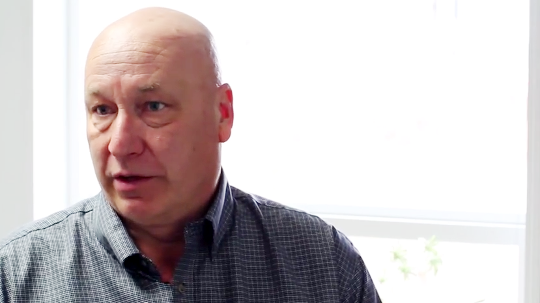
(Image from Morrow Pacific project)
The concept of a bicycling corridor being more important to Oregon than a freight rail connection, an idea which a state committee is likely to validate on Thursday, is drawing sharp criticism from some Oregonians.
“How does a bike/ped project displace a project that benefits multiple regions and benefits numerous businesses? Bike/ped does not belong.”
— Paul Langner, Teevin Brothers
As the state prepares to award $7 million of its $42 million “Connect Oregon” program to projects like the Tualatin River Greenway, some people involved in the process are sharing their dismay in the hope of changes during the next funding cycle.
“A project that will take 5,000 trucks off the highways is not funded, however a project to give bicycles away is scored high,” wrote Paul Langner, a waterfront facility manager for Teevin Brothers in Rainier who sat on both Connect Oregon’s freight and marine modal committees.
Langner was referring, in comments about the process (PDF page 120) to the Oregon Department of Transportation, to two projects that didn’t quite make the cut: his employer’s $2.7 million request for a rail consolidation facility that would gather goods like steel, rebar, cabinets and farm equipment from across the state for rail and barge shipments to Hawaii; and Eugene’s $900,000 request to fund a citywide bike share system, which had scored slightly higher.
“I sincerely question the ODOT economists’ determination of what is statewide significance,” Langner wrote. “How does a bike/ped project displace a project that benefits multiple regions and benefits numerous businesses? Bike/ped does not belong.”
To judge from the comments, the legislature’s decision to include biking and walking projects, a big victory last year for the Bicycle Transportation Alliance, was the most controversial part of this year’s program.
“Figure out how bike/ped qualifies as ‘Statewide Significance,'” one unsigned comment read. “We dwelled on this ad nauseum.”
“There is real concern about spending scarce transportations dollars on bike paths,” said another unsigned comment. “This is a conversation that needs to be take place before ConnectOregon VI occurs.”
I couldn’t call up the anonymous commenters to better understand their views. So I called up Langner. We had a great conversation, excerpted below.
In my circles, people are pretty happy about bike projects getting funded, so I wanted to get your take.
This is just my bullshit opinion, but I’ll give you my two cents.
“If there was a project that built a 10-foot wide path all the way from Portland to Eugene that paralleled I-5, I would personally get money out of my pocket.”
When we started the Connect Oregon program in 2003, the goal was to find alternative methods to fund transportation infrastructure that can’t use the gas tax. Not selected in Connect Oregon V was a project for a company that exports off to Hawaii material that comes from 80 different firms. That project didn’t get funded. Structural steel coming out of Ontario, Ore, rebar that comes out of McMinnville. Farm equipment that comes out of Pendleton, and then specialty projects that come out of Corvallis and out of Portland. According to the application from TriMet for the bike path, a poor struggling company by the name of Nike needed a bike path to get to the MAX station.
The Union Pacific Bridge project in Connect Oregon IV — there wasn’t a lot of jobs created but it took a speed restriction off the railroad bridge. All of a sudden the entire statewide rail system was moving twice as much. Those are statewide significant projects in my little pea brain.
Advertisement
‘Statewide significance’ seems tough to define. But in my own pea brain, it seems like it’s different from just “traveling long distances.” The goal isn’t just to move things around, right? We want to create value.
I really struggle with the regional allocations in Connect Oregon. You get some projects that really really stink. They’re not just dogs – they’re like skunk projects. We funded buses to run around to the hotels and take people to the Indian casinos. Are you kidding me?
I’m not just a freight proponent, but freight is a big piece of it. It’s something that keeps the entire state of Oregon competitive by creating something, especially by enforcing intermodal connectivity – something that has a benefit to Farmer Brown or poor old Jeld-Wen windows. They can actually get a product up to the Port of Portland or the Port of Coos Bay without putting it on the highway.
Were you surprised that the legislature made bike/ped eligible for these grants?
I understand that they’re going to throw something on because that looks good to their constituents. I expected one or two projects to make it. I didn’t expect them to show as well as they did.
But the committees, who are supposed to function as the voice of the people, they were filled with people who say that’s what’s important for the Millennials. Well, yes it is, but what about the intermodal connectivity? “Well they can ride their bike to the bus station.”
I have the feeling that people would say bike/ped is the same as transportation, and you’re really not. Amtrak, public transportation, always gets short shrift. I’d like to see that go further. I can’t get from Rainier, Ore., to the airport by public transportation. But once I get off the plane in Amsterdam, I can grab the commuter train that runs off to Antwerp, meet my friend there and have a beer without touching a car.
But that’s just the thing, right? Antwerp has a lot more people than Longview-Rainier. I used to live in Longview, and it seemed to me that the area has had a really rough 30 years. Since then, the way I think about the U.S. economy is that we’re just not going to make stuff any more, we’ve got to make ideas. So the way to benefit the economy is to make places really nice, so people will choose to live there.
We’re not that far apart. I do see the value in livability, and bike/ped is an important piece of it. But it needs to have some sense of connectivity. The City of Rainier takes ODOT money for road projects, and when we do, we have to install a bike lane. So here’s a bike lane that’s five blocks long. The upwards end doesn’t connect anything to the downwards end.
If there was a project that built a 10-foot wide path all the way from Portland to Eugene that paralleled I-5, I would personally get money out of my pocket.
——
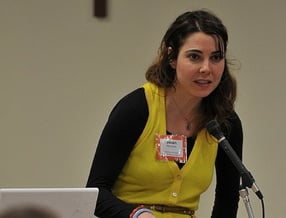
(Photo: J. Maus/BikePortland)
After talking to Langner, I spoke to his counterpart Susan Peithman, a former BTA staffer who also sat on several Connect Oregon committees and supports funding for bike projects.
Pethiman agreed that now that biking and walking projects are competing directly with different modes for the first time in decades, biking supporters need to get better at making the case for “statewide significance.”
“We had been operating in a marginalized space and we asked to sit at the big table,” Peithman said. “And we did. And we fared well. And there’s going to be more backlash because there’s going to be more people looking at what we’re doing. … So we have to bring our A game. No bones about it. Good projects and good arguments.”

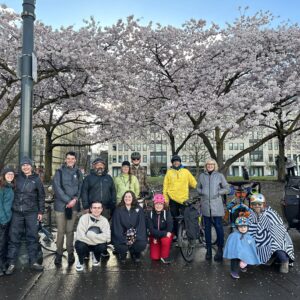

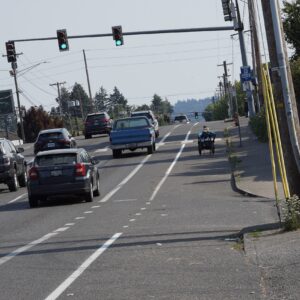
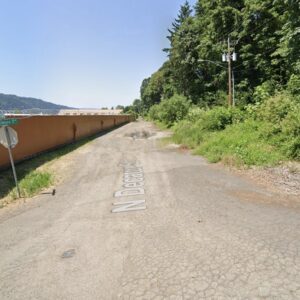
Thanks for reading.
BikePortland has served this community with independent community journalism since 2005. We rely on subscriptions from readers like you to survive. Your financial support is vital in keeping this valuable resource alive and well.
Please subscribe today to strengthen and expand our work.
Good article Jonathan, thanks for presenting both sides. You can definitely see where Paul is coming from.
I agree and appreciate a balance of opinions on this site. While the goal is bike/ped advocacy, we all benefit from at least attempting to see the other side. More articles like this please.
Thanks dan… But this article was the work of Michael Andersen. Remember to notice the byline ;-)!
Several years ago, our local school superintendent was detailing how decreased state funding was going to impact class sizes and staff layoffs in the coming months. A parent asked, “So should we be going to [the local legislator’s] town hall and advocate for more education budget?”
The superintendent replied, “By all means, advocate for education, but do it as a citizen. Be aware that more money for schools may mean that someone’s grandmother goes without medication or that a public hazard remains in place. Know what you’re really asking.”
As biking becomes a part of ordinary budgeting, I think similar advice is worthwhile. I don’t know the details of Connect Oregon’s budget; for all I know, the committee aced the priorities, so this is not a critique of the outcome. It’s just an acknowledgment of Mr. Langer’s point that good citizenship requires a broad view of significance.
“I don’t personally use something, therefore I think it’s a waste of money. Fund this other thing I do use instead.”
– Everyone
Oversimplifying, I think. The challenge here is that the two projects have totally different benefits — it’s not like street paving vs. bike lane painting where it’s easier to make an apples-to-apples comparison.
Besides, who’s to say that cyclists wouldn’t benefit just as much from taking 5,000 semis off the road as they would from a bike path?
well, just to play devil’s advocate here, what about all the jobs those 5,000 trucks represent? what happens to them?
they lost their jobs, couldn’t afford to keep their cars, and now they need somewhere to ride their bike…
Many if not most those truckers aren’t necessarily local. Truckers check in and out of areas, big manufactures often hire trucking companies to do their shipping. I know (working in construction) I often get loads of building supplies trucked in from Mississippi but the trucker picked up the load to get close to home here in the PNW after dropping off a load somewhere near Mississippi.
And recently, many more truckers are from Mexico since the US opened up its boarders to Mexican trucking companies for delivering US goods within the US.
Basically a truck driver isn’t necessarily from the geographical location of the cargo they haul. So those 5,000 less truck drivers would be from pretty much anywhere in the in North Western hemisphere.
Also, 5,000 trucks off the road doesn’t mean 5,000 truckers, just 5,000 trips (?per year, month?). Just like the 200 trips a day on your street isn’t 200 drivers. At most the trips per day represents half as many drivers.
Currently, there’s a driver shortage of about 25,000 – 30,000 in trucking nationwide. They’ll find other loads, routes and deployments almost immediately.
I didn’t really read that attitude out of this exchange. This was a good read though, Michael. I have been pretty happy with the content you have added since you’ve been at BP. Keep it up.
I think Susan may have hit the nail on the head with her marginalization take. Maybe bike/ped is getting a number of “make up calls” for years of neglect. I don’t think I’m going to be too upset about that.
No mention that much of these ‘freight’ upgrades he’s talking about are targeted towards increasing the speed and frequency of oil trains up to Clatskanie.
It’s funny that he mentions wanting an upgraded freight rail facility but the only freight metric the business community wants to talk about is OTR truck numbers.
It seems that truck congestion is their measurement of success.
Well, okay then!
It’s already partially built – you really only need to finish the part from Oregon City to Eugene.
It seems like a statewide network of 10-foot-wide bike/ped paths, connecting Portland to Eugene to Grants Pass to Medford to Ashland, and Astoria to Portland to Hood River to Pendleton, and Hood River to Bend to Klamath Falls, etc., etc., really should be built, and it really would be widely supported.
Why aren’t more folks talking about this?
Germany built such a network decades ago…
I barged in here prepared to point out the imagined hypocrisy of some mid-state Republican complaining how the government wasn’t handing out enough money to buy stuff for private business. (“You didn’t build that!”) But he seems decent with a defensible point of view. And the political contributions of his employers seem reasonable too. So, nice work BP. You influenced my pre-existing opinions.
Still though: Yay bike/ped!!! Wheeee!
I AM furious! Furious that they aren’t prioritizing clear cutting and coal production which my business profits from.
(Over simplying, yes. Whiny? Yes. Comparing apples to oranges? Yes.) Once we start seeing commercial freight in mass capacities enjoying the scenic byways while improving their physical and emotional well being, then we can talk.
I sat on the advisory committee in Corvallis for transit for several years and we faced the problem of people thinking that mass transit should do things that it can’t do well. Rainier is a town of less than 2000 people located over 50 miles from the Portland Airport. It does not make sense to try to create mass transit to connect these two points as there simply are no where near enough trips made to have the service make sense. If you want good mass transit you need to move to a place with the density to enable it. We should stop wasting our transit dollars on rural routes.
I somewhat disagree. A transit route with express service from Rainier to Portland would not make sense. A transit route from Astoria to Portland, with a stop in Rainier, definitely would begin to make sense. Make it electric interurban rail; allow those electric locomotives to pull both passenger and freight on the same rails; and make sure that there is plenty of zoned capacity for residential and employment growth within a mile of each station. Make sure bike paths connect each station well to the surrounding communities. Then, all of a sudden, there is a recipe for economic development and growth that could benefit everybody, as well as the potential to build a worthwhile transit system.
“I can’t get from Rainier, Ore., to the airport by public transportation.”
Indeed, you can. Columbia County Rider from Rainier will take you to St Helens, and from there direct transfer to bus to downtown Portland, and from there MAX to the airport. If you catch the 8am bus in Rainier you can be at the airport by a little after 10am. There are 2 other buses (mid day and late PM) as well.
That was going to be my point exactly. Thanks Art for noting this. He’s obviously not tried to find out whether this could be done. Perhaps his peers all believe this sort of nonsense too. If they all started taking the bus the chances of it running much more often would increase. Lame.
> According to the application from TriMet for the bike path, a poor struggling company by the name of Nike needed a bike path to get to the MAX station.
Says the gentleman starring in an ad paid for by a foreign energy firm that describes itself* as a leading exporter of US coal.
I’ll support subsidizing a bike path for well paid shoe designers (or the janitors that support them) over subsidies to wealthy private freight rail companies (or the billion dollar coal and oil industries that support them) any day.
*: source: Ambre Energy’s website.
Didn’t even notice the source of the photo.
I hate Nike, but I hate tar sands, fracking, mountaintop removal, and climate change even more.
FWIW, when I asked if it was OK with him if we used that photo, Langner mentioned that he lent his face/time/name to the coal export project not because he supports coal exports (he said he doesn’t; he thinks the United States should avoid exporting domestic energy sources in preparation for an energy-scarce future) but because he supports marine exports in general.
Don’t let the present stand in the way of a perfectly good future. Freeing up labor capacity for more productive uses through increased efficiency is good in the long run.
I agree, but besides the ones who get jobs on the railroad or as buggy whip makers, let’s make sure the rest of our family, friends and neighbors have good options available to make the transition while remaining viable members of society.
As a cyclist, I have to admit that I can see value in a project that would take 5000 trucks off the road, if that’s really what it would do.
“We had been operating in a marginalized space and we asked to sit at the big table”
look at that, biking is all grown up now and eating grown-up potions… suddenly you’re not the only one that wants that last piece of steak…
are you going to recognize that growing requires more energy and give up more of your share?
or are you going to continue eating as much as you want while stunting the grown of the up-and-comer?
“…comments about the process…” ftp://ftp.odot.state.or.us/outgoing/OTC/07_July/July_17_2014_OTC-Meeting_Packet.pdf
“…“I sincerely question the ODOT economists’ determination…”…Langer quote from this bikeportland story.
I’ve not downloaded the pdf and studied the process ODOT uses to rank projects proposed for inclusion in distribution of money from Connect Oregon. Maybe someone else reading here has already studied that process.
It seems the ranking system of that process is what Langer questions. I’d like to think he’s studied it, and I wish he’d been asked his opinion about it for this interview.
Langer is pitching the rail consolidation facility, and it’s hard to blame him for that. The state, still growing it seems, definitely is need of considering ways by which to have its transport system and its transportation system become more efficient and cost effective. Bike share systems are yet a kind of new, unproven idea in the U.S. bu in different ways, they do seek to address these same objectives.
It may well be that the rail consolidation facility is of significant statewide value, and it may even have been dropped in favor of some less-worthy projects. But going after bike/ped, which is easy politically in many corners because it doesn’t seem serious to a lot of people, seems a little like picking on the little guy.
“So here’s a bike lane that’s five blocks long. The upwards end doesn’t connect anything to the downwards end.” Well, yeah, and that’s precisely why bike/ped projects are of statewide importance: because we have a statewide problem with state highways that are hostile to bikes and pedestrians. Keep building those 5-block-long bike lanes mandated as part of road projects, and we start building a network. THAT is of critical importance to Oregon, especially with the looming bike tourism boom.
I agree, plus once there are freight rail enhancements, what’s to stop them from becoming passenger rail when/if the mix and use of freight on them changes? I’m of the opinion that any rail improvements are a good thing regardless of the immediate use they might be put to.
This is the part that gets my goat:
Langer says “I have the feeling that people would say bike/ped is the same as transportation, and you’re really not.”
Bike/ped IS transportation. When I’m riding or walking, I’m transporting myself to my destination, same as if I was driving or taking public transportation.
More connections in our bike lane/sidewalk/MUP networks means I can transportate myself easier/safer/faster/more directly in a variety of ways, some of which actually help to reduce car and truck congestion.
I think it’s more of he shouldn’t be equating “transportation” with “shipping”. One transports people and one transports goods.
I looked carefully at the ConnectOregon grant application process when I asked ODOT to pull Portland’s grant application for bike share due to the outrageous and conscious lies about the existence of a bike share sponsor.
The grant was finally pulled due to reporting by the Mercury and WW, (after the story was broken by Baby Gorilla). but the Oregon State Bar refuses to sanction Novick on its own behalf and there were no sanctions from ODOT. Jeeze- we make Chicago look honest.
My concern is that the whole grant process is rubbish. There is an aura of citizen involvement, but the final decisions seem to line up with who would get money if political pull was the only issue. Of course Betsy Johnson’s project in Saint Helens will succeed, and rural areas will get short shrift.
If we were dealing with Federal funds and not lottery funds, the feds would be investigating Connect Oregon the same way they are looking at criminal charges for grant fraud in relation to Cover Oregon. But the feds have standards for applications (no lies) and we don’t.
“Jeeze- we make Chicago look honest.”
Unjustified swipe at the state we live in. Actually, this recent article by Fortune Magazine rated Oregon as one of the ten least corrupt states.
http://fortune.com/2014/06/10/most-corrupt-states-in-america/
Porter, between Patrica McCaig being a lobbyist/aide de camp for Kitz, the criminal investigation into Cover Oregon, and what I observed about grants- well, those are all Chicago-style practices. My swipe was justified- this state needs to do better.
Let us look at things again here… Every time I pay for gasoline, I pay taxes on it, and out of each tax dollar that gets spent for roads, I as a bicyclist get only $0.005 (yes, that’s half a penny) for my needs.
Clearly we are getting our fair shake… NOT!!!
“This is just my bullshit opinion, but I’ll give you my two cents.”
How about a full nickle?